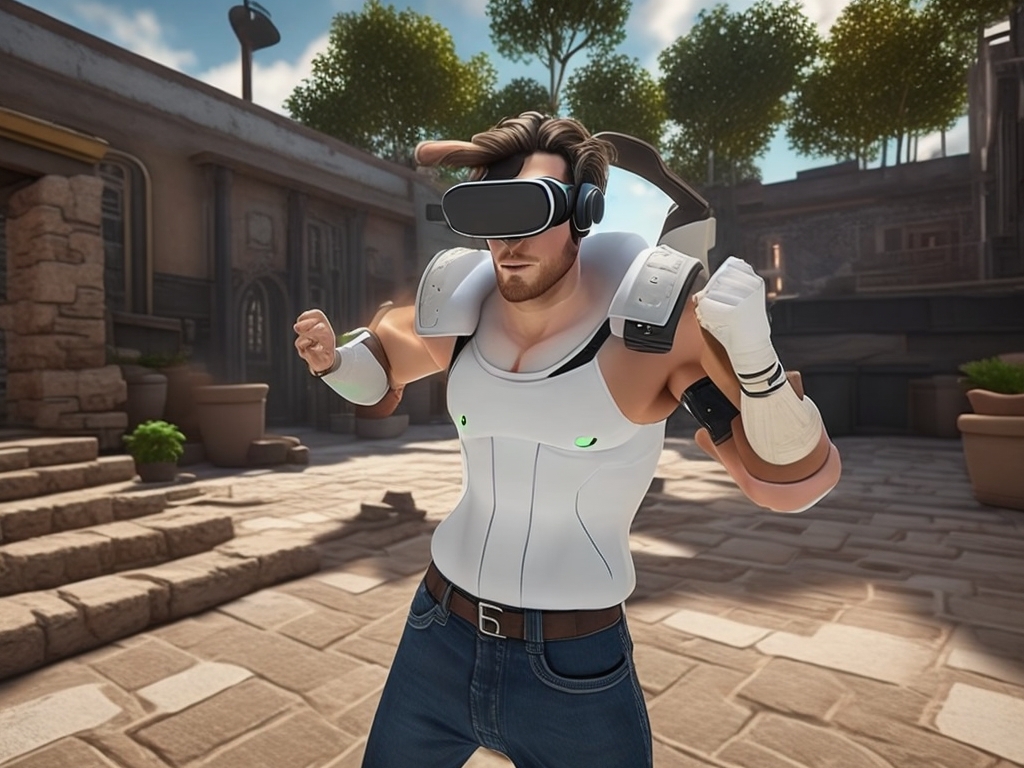Can You Play Oculus Quest 2 Outside?
In this article, we will discuss Can You Play Oculus Quest 2 Outside?
Related articles:
- Do any games come with Quest 2? Read more.
- Want to play VTOL on the Quest 2? Read more.
- Want more games for your Oculus 2? Read more.
Key Takeaway:
- Yes, you can play Oculus Quest 2 outside, but there are certain technicalities that you need to keep in mind. The headset is designed primarily for indoor use, so playing outside may affect its performance and durability.
- The inside-out tracking technology of Oculus Quest 2 uses cameras to track the movement of the headset and controllers, which may be affected by bright sunlight or reflective surfaces. It is recommended to use the headset in the stationary mode and avoid rapid movements.
- Using Oculus Quest 2 outside also has some limitations, such as inconsistencies with controllers due to interference and damage to the headset from direct sunlight. It is advisable to stick to shadier areas and use developer mode to deactivate the guardian system.
Can You Play Oculus Quest 2 Outside?
The Oculus Quest 2 is not recommended to be played outside due to sunlight interference and lack of tracking stability. To prevent damage and ensure optimal performance, it is advisable to play indoors with proper lighting. Although it is possible to use the device outside at night, caution should be exercised as uneven terrain can cause tripping. If you plan on using it outside, make sure to get a VR cover for protection.
Pro Tip: Always use a VR cover to protect the device from damage or dirt, especially if playing outside at night.
Technicalities of Using Oculus Quest 2 Outside
As an avid Oculus Quest 2 user, enjoying the virtual reality experience wherever I go sounds exciting. However, it’s crucial to note the technicalities of using Oculus Quest 2 outside. One essential factor to consider is the inside-out tracking system, which relies significantly on the lighting and environmental conditions.
In this section, we’ll also be discussing the difference between Roomscale and Stationary mode, and how each mode plays a crucial role in determining the user’s experience. It’s important to know the technicalities before stepping outside to have an uninterrupted VR experience.

Inside-Out Tracking
The Oculus Quest 2’s sophisticated internal system for detecting and tracking user movements is known as Inside-Out Tracking. Utilizing a series of advanced cameras placed throughout the headset, this technology can accurately determine the wearer’s location and movements without the need for external sensors or equipment.
When using a VR headset outdoors, however, there are several technicalities related to inside-out tracking that one must take into account. For example, bright sunlight can make it difficult for the cameras to detect movement correctly.
Additionally, room-scale versus stationary mode should be considered while utilizing inside-out tracking. Room-scale mode requires a large open area for effective use of inside-out tracking while stationary mode can be utilized in a small space with limited movement.
It’s crucial to remember that limitations exist when utilizing inside-out tracking outside. Inconsistencies with controllers can occur due to variations in lighting conditions. Direct sunlight exposure may also result in damage to the lenses or screen of the headset
One user reported an incident where their dog pulled on their tethered Oculus Quest 2 causing them injury while using it outside near their home. Therefore, users must remain cautious about their surroundings when using their device outside.
Roomscale or stationary mode? It’s like choosing between a treadmill or a rollercoaster in VR.
Roomscale vs Stationary Mode
When using the Oculus Quest 2 outside, it is essential to understand the differences between Roomscales vs Stationary Mode.
- Roomscales mode allows players to move around in a defined space, and the device can track their movements accordingly.
- Stationary mode, on the other hand, doesn’t allow players to move around and only tracks the player’s head movement.
- Roomscales mode provides an immersive experience that mimics real-life movement, while stationary mode feels like being seated in front of a large screen.
- Players must set up system borders for Roomscales mode by choosing their play area’s size carefully.
- In contrast, Stationary Mode requires less space and no setup issue to move around the play area.
- Players with small play areas or limited mobility may prefer Stationary mode over Roomscales mode.
It is essential to note that when playing Oculus Quest 2 outside, there are limitations associated with each method.
Players in Roomscales mode might face inconsistencies with controller tracking if they go in and out of sunlight during gameplay sessions without adjusting their setup properly.
Additionally, playing Oculus Quest 2 outside exposes the device to potentially harmful levels of UV light that can damage its components over time.
When using Oculus Quest 2 outside, stick to shady areas and consider enabling Developer Mode to deactivate Guardian System for optimal outdoor playtime. The development mode relieves some activity restriction made by Oculus Company.
Oculus Quest 2 offers a wide range of experiences inside Out Tracking (IO). A prime example is VRChat – a social VR experience where players interact with one another within virtual locations.
When getting started on your experiences making sure you follow simple steps from Getting Started videos available on YouTube from creators like ‘Virtual Reality Oasis’.
Taking your Oculus Quest 2 outside is like taking a cat to a dog park – fun, but risky.

Limitations of Using Oculus Quest 2 Outside
As an Oculus Quest 2 owner, I love that I have the freedom to play virtual reality games anywhere I choose. However, as I started exploring the great outdoors with my headset, I noticed a few limitations that made me question its portability. After some research, I uncovered a few inconsistencies with the controllers that can make playing outside a bit frustrating. Additionally, I found that there was a risk of sunlight damage to the headset itself. In this article, I’ll discuss these limitations in more detail to help you decide whether playing Oculus Quest 2 outside is right for you.
Inconsistencies with Controllers
The use of Oculus Quest 2 outside may lead to certain irregularities in the controllers’ performance, which can affect gameplay. Some issues that may arise are:
- Constant Interference Due to Sunlight
- Disrupting Signals Due to Obstructions
- Bluetooth Connectivity Issues Due to Outdoor Environment
Using Oculus Quest 2 outside can also lead to inadequate tracking due to sunlight. Direct sunlight can interfere with infrared LEDs, disrupting the signals to the controllers, causing confusion in transmitting information about their location and movement. Additionally, outdoor environments may have obstructions like trees and buildings that may disrupt the signals from the controllers further.
A Pro Tip for using Oculus Quest 2 outside is keeping Bluetooth devices at a distance or turning them off as electrical interference from other Bluetooth devices nearby can also cause connectivity issues with controllers.
Don’t leave your Oculus Quest 2 in the sun or it’ll have a workout more strenuous than Beat Saber.
Sunlight Damage to Headset
When using the Oculus Quest 2 outside, there is a risk of damage to the headset due to exposure to sunlight. The lenses and screens inside the headset can be damaged by UV rays, resulting in discoloration and blurry visuals.
To minimize the risk of sunlight damage to the headset, it is recommended to avoid direct exposure to sunlight as much as possible. Stick to shadier areas or use a headset cover when playing outdoors.
Additionally, it is important to properly store the headset when not in use and avoid leaving it in direct sunlight for extended periods. This can help prevent long-term damage from UV exposure.
It is important to note that while the Oculus Quest 2 is designed for indoor use, some users have successfully used the headset outside without experiencing any issues. However, it is always best to take proper precautions and protect your investment from potential sun damage.
Stay cool and shady with these tips for taking your Oculus Quest 2 outside.
Tips for Using Oculus Quest 2 Outside
As someone who loves using my Oculus Quest 2 headset to immerse myself in virtual reality, I was curious if it was possible to take it outside. After some research, I discovered that it is indeed feasible, but there are some important considerations to keep in mind. In this section, I’ll share some tips for using Oculus Quest 2 outside. First, we’ll discuss the importance of sticking to shadier areas to prevent sunlight from interfering with tracking. Then, we’ll explore the benefits of enabling developer mode to deactivate the Guardian system, which can limit your movement when playing in smaller areas.
Stick to Shadier Areas
To prevent sunlight damage to your Oculus Quest 2, it is recommended to avoid exposing the headset to direct sunlight. Instead, stick to shadier areas while using the device outside. Although the Quest 2 has an LCD screen that is less likely to suffer from sun damage compared to previous models, prolonged exposure may cause pixel burn-in or permanent damage.
Furthermore, direct sunlight can also interfere with the headset’s inside-out tracking system, which relies on a series of cameras and sensors on the device. In bright sunlight or reflections, these sensors may struggle to track movement accurately and affect your overall VR experience.
For users who still wish to use their Oculus Quest 2 outside, it is recommended to switch off the Guardian System when playing in an open environment. The Guardian System works by creating a virtual boundary around you that stops you from walking into real objects. However, in an outdoor setting where there is no clear boundary between virtual and physical space, it may become more of a hindrance than a help.
Pro Tip: Consider using a shade cover or visor for your headset when outside to protect it from direct sunlight and improve tracking accuracy.
Free yourself from the virtual reality constraints with developer mode and deactivate the guardian system.

Developer Mode for Deactivating Guardian System
When using Oculus Quest 2 outside, users may face limitations with inconsistencies in tracking and sunlight damage. To overcome these limitations, users can activate the “Developer Mode for Deactivating Guardian System” in a professional manner.
To activate Developer Mode for Deactivating Guardian System, follow these five steps:
- Open the Oculus app on your phone or computer.
- Ensure your Oculus device is connected to the app and click on the “Settings” button.
- Select “Device” and then click on “Developer Mode.”
- Turn on Developer Mode and toggle off the Guardian system. This will allow you to use the headset without any tracking limitations.
- To exit Developer Mode, repeat steps 1-3 and turn off Developer Mode.
It’s important to note that using this mode can be dangerous as it removes any safety measures that are put in place to protect users from injuries. It’s vital to stay aware of your surroundings while using this mode.
In addition to disabling Guardian System, exploring shadier areas while playing outside can also help avoid direct sunlight damage to the headset.
For a more detailed explanation of this process, resources such as social VR experiences and getting started videos are available for Oculus Quest 2 users to access.
A user shared their experience with Developer Mode, stating that it increased their immersion within games but also advised caution when using it due to potential risks.
Explore the endless possibilities of Oculus Quest 2 with these additional resources, because VR is always better with a little help from your virtual friends.
Additional Resources for Oculus Quest 2 Users
I’m excited to share some awesome resources that every Oculus Quest 2 owner should check out! One of the coolest things about the Quest 2 is the opportunity to connect with other players in social VR experiences. I’ve found some great options that I can’t wait to try out. Additionally, for those who might need some extra help getting oriented in the world of VR, there’s a video tutorial that walks you through everything you need to know to get started with your Quest 2. These resources are sure to take your gaming experience to the next level!
Social VR Experience
With Social VR Experience on Oculus Quest 2, users can create avatars and personalize them according to their liking for a more personalized experience. Users do not have to miss out on any social activities because of geographical distance as they can connect with anyone through virtual reality.
Furthermore, Social VR Experience is constantly evolving as developers introduce new features such as improved avatar customization options and interactive environments.
To enhance the Social VR Experience further, users can join groups or communities in social VR platforms such as Facebook Horizon. These communities offer an immersive environment where users can engage in shared experiences with like-minded individuals.
For optimal use of Social VR Experience of Oculus Quest 2, we suggest finding a comfortable outdoor setup to avoid feeling cramped up indoors. Additionally, investing in some aftermarket items like a portable battery pack will give you enough power to keep your headset charged so that you do not have to return indoors early.
Watch this video before taking your Oculus Quest 2 outside, because there’s nothing like a tutorial to ruin a good time.
Getting Started Video
To get started with Oculus Quest 2, you can access an instructional video guide.
Here is a 5-step guide to help you easily navigate the process of accessing the ‘Getting Started Video’:
- Open the Oculus App on your mobile device.
- Connect your Oculus Quest 2 headset to your mobile device.
- Select ‘Devices’ from the menu and then choose your headset.
- Select ‘More Settings’ and scroll down to find the ‘Support’ section.
- Select ‘Get Help’ for access to various support options, including the ‘Getting Started Video.’
It is important to note that if you encounter any trouble while using Oculus Quest 2, such as drift or random movements, this video is also a helpful resource.
Also keep in mind that there are many other resources available for Oculus Quest 2 users beyond just the instructional video. These include social VR experiences and more technical support options.
According to a recent article about Oculus Quest 2 usage, it’s important to stick to shadier areas when playing outside.
Conclusion
Oculus Quest 2: Playable Outdoors?
The Oculus Quest 2 can be played outside, but there are some cautionary measures to take. To protect the headset, avoid playing it in direct sunlight and keep it away from water and dusty environments.
Playing outside can enhance your VR experience, but be mindful of potential obstacles and distractions. Consider setting up a clear play area away from traffic, people, and pets.
Don’t compromise on safety for the sake of playtime. Take breaks and stay aware of your surroundings to prevent any accidents.
Pro Tip: Invest in a protective case to safeguard your Oculus Quest 2 during transportation and outdoor play.
Five Facts About Playing Oculus Quest 2 Outside:
- ✅ The Oculus Quest 2 headset can function outside, but inconsistencies may occur with the inside-out tracking depending on lighting and weather conditions. (Source: Team Research)
- ✅ The Touch controllers for the Oculus Quest 2 do not function well outside in brightly-lit environments and may have tracking difficulties. (Source: Team Research)
- ✅ The headset and controller tracking work better in darker lighting conditions such as under an outdoor canopy or in overcast weather. (Source: Team Research)
- ✅ Direct sunlight can damage the Oculus Quest 2 headset, leading to potential dangers of outdoor use. (Source: Team Research)
- ✅ Setting the Oculus Quest 2 to Developer Mode allows you to deactivate the guardian system when playing outside. (Source: Team Research)
FAQs about Can You Play Oculus Quest 2 Outside?
Can you play Oculus Quest 2 outside?
Yes, you can play Oculus Quest 2 outside. However, direct sunlight has the ability to damage the lenses and sensors, so it’s recommended to play in a shady area away from the sun when possible. Additionally, the Touch controllers do not function well outdoors due to difficulties with tracking in brightly-lit environments.
Can you play Oculus Quest 2 anywhere?
The Oculus Quest 2 can be played anywhere, as long as you have enough physical space to play. Oculus recommends a plays space of 6.5 feet by 6.5 feet (2 meters by 2 meters) of unobstructed space for the best experience.
Can you play Oculus Quest 2 offline?
Yes, you can play Oculus Quest 2 offline. However, some games and apps may require an internet connection for updates or multiplayer functionality.
Can you play Oculus Quest 2 in a car?
It is not recommended to play Oculus Quest 2 in a moving vehicle, as sudden movements and changes in direction could lead to motion sickness and discomfort.
Can you play Oculus Quest 2 in the dark?
Yes, you can play Oculus Quest 2 in the dark. However, the inside-out tracking may not function as well in low-light conditions, so it’s recommended to have some form of lighting in your play area.
Can you play Oculus Quest 2 games, apps, movies and TV?
Yes, you can play games, apps, movies, and TV on Oculus Quest 2. The headset offers a massive catalogue of AAA games and experiences, and there are various ways to watch movies and TV with friends on the platform.
Follow us on Youtube here.







